In 1979, NASA’s Voyager 2 spacecraft hurtled through the Jupiter system on the first leg of its historic mission to all four outer planets. During its flyby, it captured a series of pre-commanded images of the planet’s four large Galilean moons. The Voyager science team was expecting to see cratered, lifeless satellites similar to Earth’s Moon. Instead, they were shocked to discover that one of these worlds, Europa, was covered in a smooth, icy shell speckled with sea salt from a subsurface ocean.
Subsequent data from the Galileo mission reinforced the hypothesis that Europa is an ocean world, but we still have far more questions about this enigmatic moon than answers. How does its icy shell remain perpetually young and unmarred by craters, even though the resurfacing waters of its ocean are many miles beneath its crust? Does Europa have geysers which spew water into space? And does its ocean contain all of the chemical ingredients required to support life?
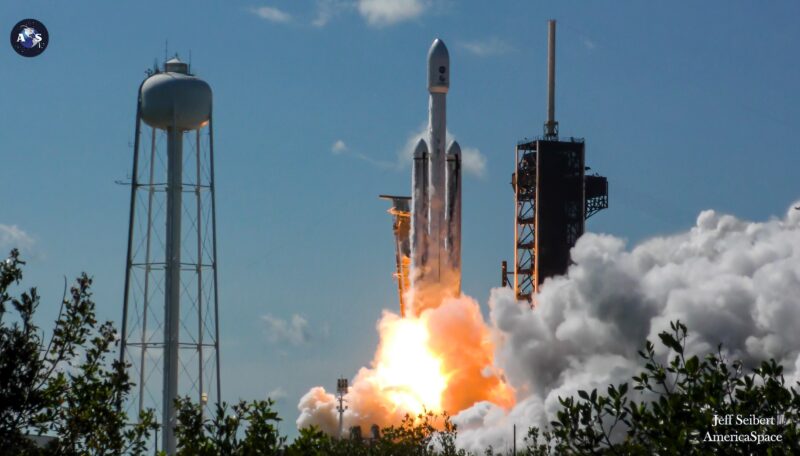
To answer these questions, as well as others which we presumably do not even know we should be asking, NASA built the $5 billion Europa Clipper spacecraft. After spending a decade in development, Clipper lifted off on Monday aboard a SpaceX Falcon Heavy rocket. The mighty triple-core launch vehicle placed it onto what engineers consider to be accelerated trajectory towards the Jupiter system. However, due to the vast gulf between the planets, it will still take five and a half years for the spacecraft to reach its destination. When it does, it will embark on an ambitious tour of the Jupiter system and seek answers to some of our deepest questions about the prevalence of habitable worlds in the Solar System.
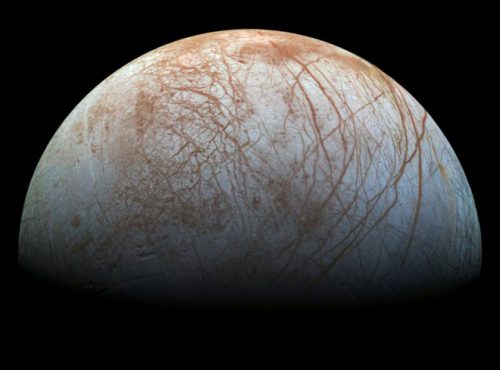
For the relatively small community of Europa scientists, reaching launch day was an odyssey in and of itself. Following Voyager’s brief flyby, the Galileo orbiter studied the Jupiter system in detail for eight years, conducting 12 Europa flybys in the process. It returned just enough data to convince scientists that Europa harbors a global subsurface ocean which may contain twice as much water as all of Earth’s oceans combined. However, Galileo was hampered by the limited sophistication of its instruments, all of which were built in the 1980s, as well as by the failure of its high gain antenna, which slowed its communications rate to a trickle.
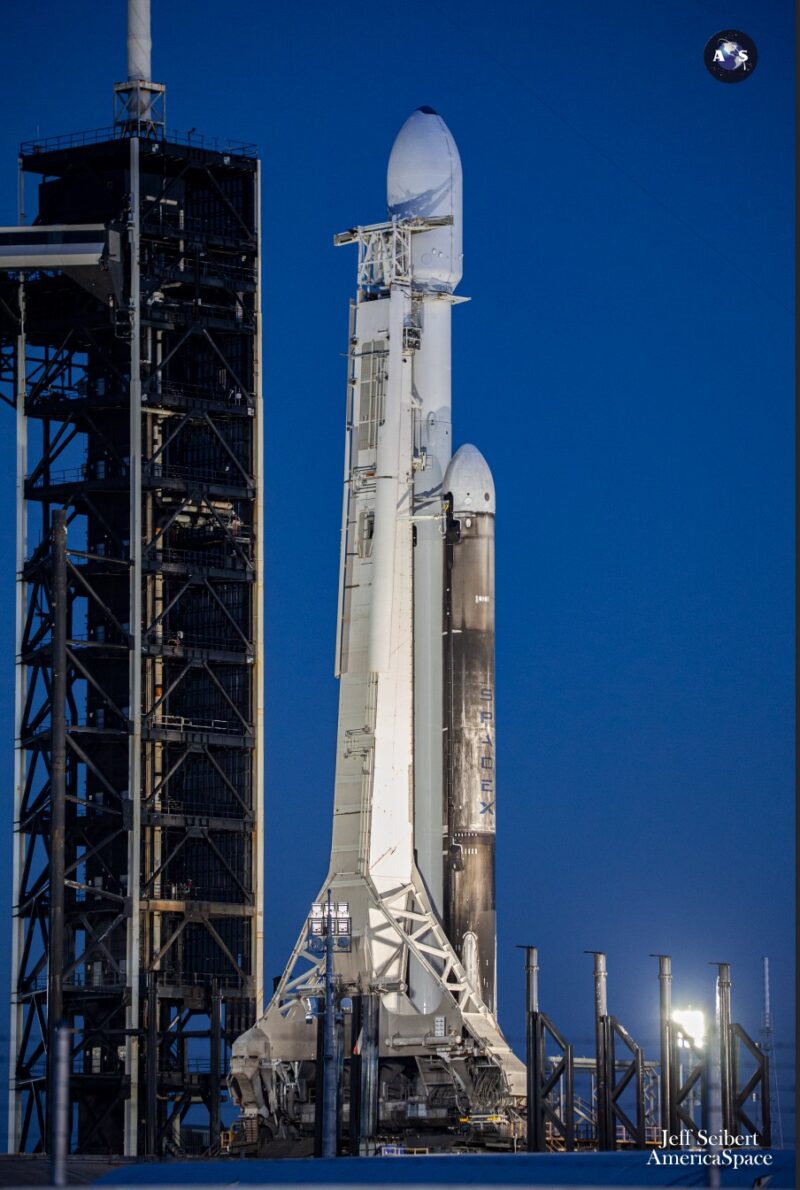
Even before the Galileo mission ended with its fiery plunge into the Jovian atmosphere, planetary scientists knew that they wanted to mount a dedicated expedition to Europa. While the ocean and its hypothetical biosphere generated no shortage of excitement among researchers and taxpayers alike, Europa is a difficult destination to reach. It is situated deep within Jupiter’s gravity well, and the magnetic field of its host planet generates hazardous radiation belts 20,000 times stronger than Earth’s familiar Van Allen Belts. Due to these challenges, as well as the fact that it is not linked to the long-term exploration of the Moon and Mars, the Europa mission became an orphan child of planetary science. It moved between different programs for nearly two decades to satisfy larger strategic priorities before finally earning permanent support.
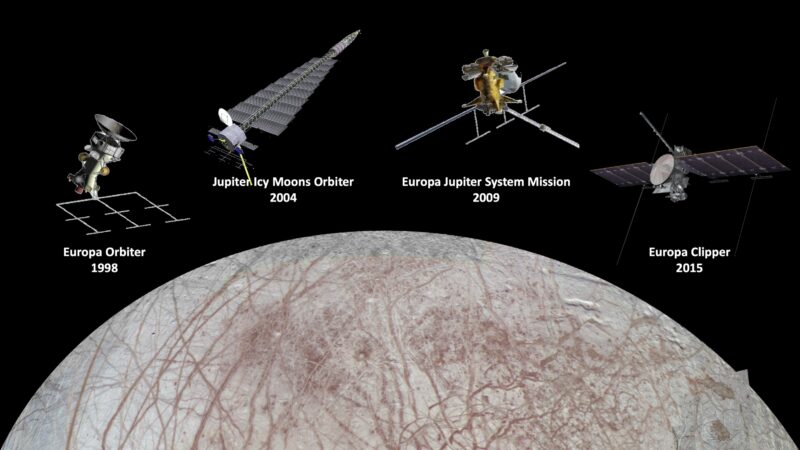
Under Administrator Dan Goldin’s “Faster, Better, Cheaper” strategy for planetary exploration, NASA began studying a lightweight, affordable spacecraft called the Europa Orbiter in 1998. Just four years later, it became collateral damage as NASA reassessed its planetary science program following the dual failures of the Mars Climate Orbiter and the Mars Polar Lander, two other low-cost missions.
In 2004, a new Europa mission was shoehorned into President Bush’s Vision for Space Exploration. One goal of the VSE was to develop nuclear propulsion technologies to facilitate the human exploration of Mars. The first mission under what NASA called Project Prometheus was the Jupiter Icy Moons Orbiter (JIMO). If it had flown, JIMO would have been far and away the most capable spacecraft ever sent to another planet. Measuring 192 feet (58 meters) in length, it would have carried 3,300 pounds (1,500 kilograms) of payload. Its nuclear-electric propulsion system would have enabled it to enter orbit around all four of Jupiter’s planet-sized Galilean moons. The catch? Developing JIMO’s advanced capabilities would have cost a staggering 27 billion dollars – 2.5 times the budget of the James Webb Space Telescope.
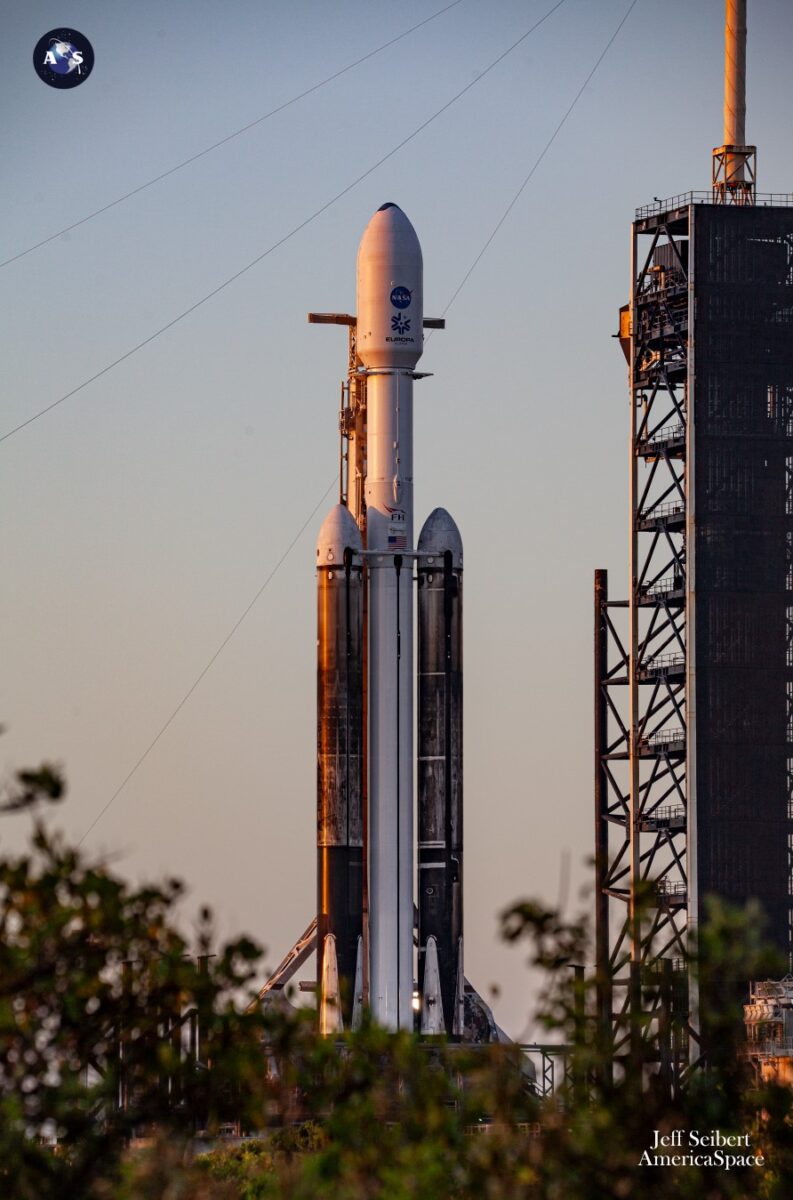
Therefore, it is not surprising that JIMO’s downfall took less than two years. It was supplanted by the Europa Jupiter System Mission (EJSM), an international mission which would have dispatched a NASA orbiter to Europa and a European orbiter to Ganymede. However, budgets were tight in the early 2010s. Because it needed to propulsively decelerate into orbit around Europa and then survive for a year in Jupiter’s powerful radiation belts, EJSM’s Europa orbiter was a very large spacecraft with a budget of 4.7 billion dollars. Once again, NASA could not afford the mission, and it sent the engineers at the Jet Propulsion Laboratory (JPL) back to their drawing boards for the fourth time.

A team of JPL engineers led by trajectory analyst Brent Buffington made a bold suggestion [1]. What if the spacecraft didn’t need to enter orbit around Europa? Instead, it could use the gravitational fields of the Galilean satellites to sculpt its orbit, facilitating dozens of Europa flybys. The spacecraft would be placed in an elliptical orbit, where it would make brief dives into the Jovian radiation belts to observe Europa from close range. That concept eventually morphed into Europa Clipper. After a three-year battle to design the spacecraft in detail and to obtain funding for the mission, Clipper was approved for development in 2015.
Europa Clipper is a Flagship-class mission. Along with human spaceflight programs, flagships are keystone national efforts which have additional justifications beyond just scientific return. They are as scarce as they are capable. Clipper is just the seventh planetary science flagship, after the Viking Mars landers, the Voyagers, Galileo, the Cassini Saturn orbiter, and the Curiosity and Perseverance rovers.
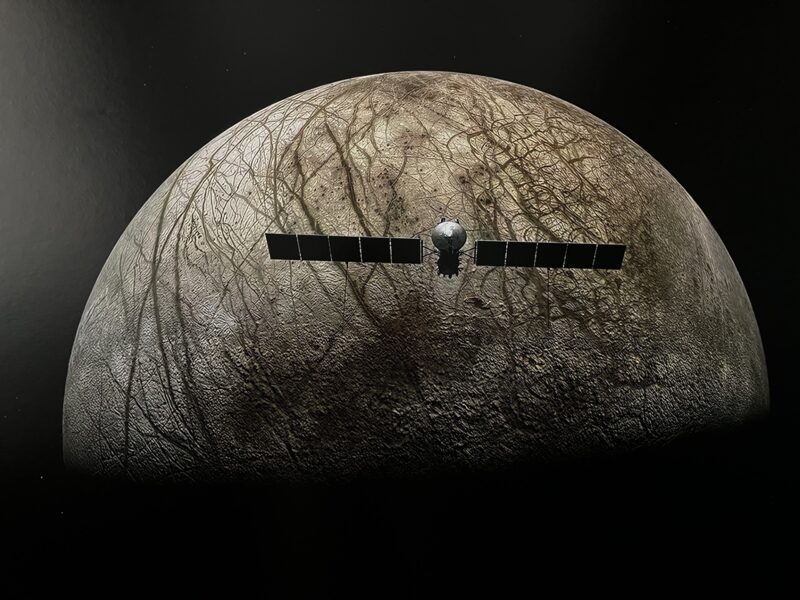
Whenever a major interplanetary mission launches, it is always a cause for celebration among planetary scientists, including this author. That is true even if the spacecraft does not study the planetary body which a scientist is most interested in. Because only one or two flagship missions fly every decade, they are supposed to generate data for the entire scientific community by answering questions from multiple scientific disciplines, including geology, chemistry, astrobiology, and particle physics. In addition, flagship mission concepts are ranked and prioritized by hundreds of planetary scientists in a 700-page report called the Planetary Science Decadal Survey [2], which is released every 10 years. Every time a flagship mission lifts off, it reinforces the validity of this process, which increases the likelihood that subsequent missions will also make it to the launch pad. Europa Clipper is no exception.
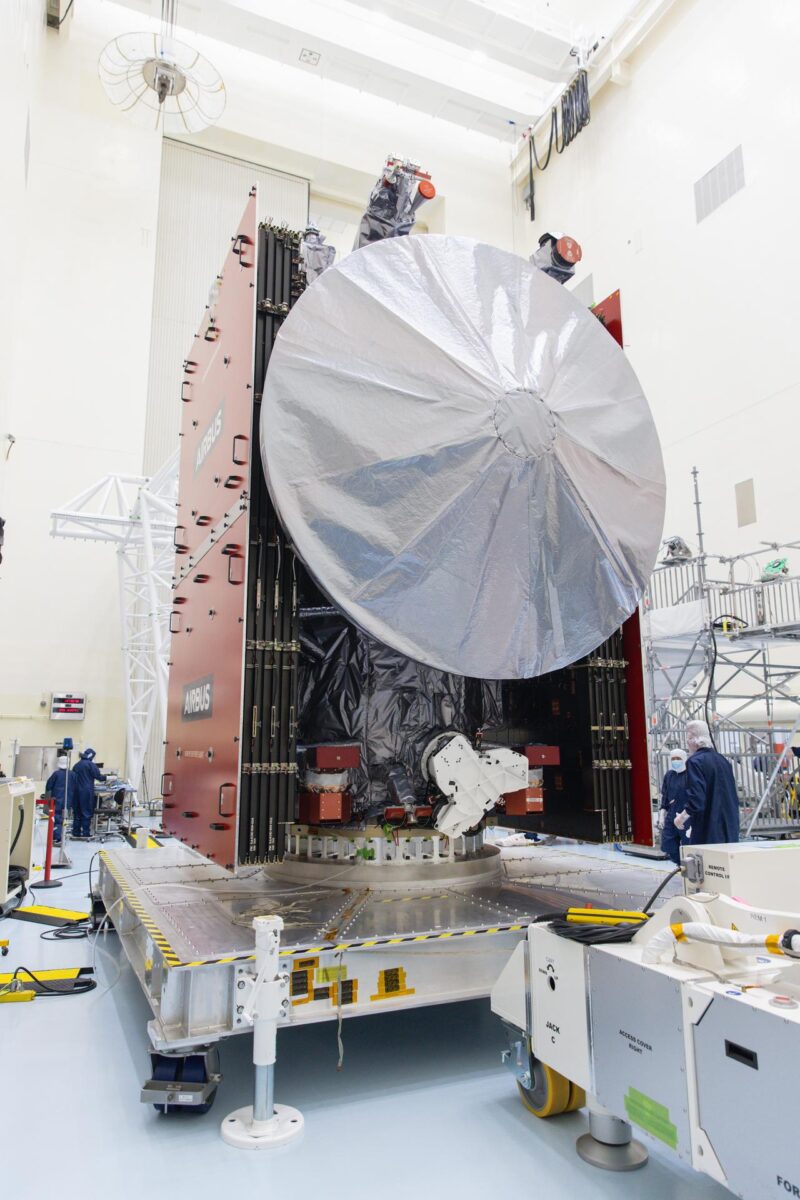
Clipper is the largest and most expensive spacecraft ever sent to another planet, breaking the records set by Cassini in the 1990s. It weighs in at over 13,000 pounds (6,000 kg), and its solar array wings span just over 100 feet (30 meters). It carries 776 pounds (352 kg) of instrumentation to study Europa and its surroundings. The nine instruments onboard the spacecraft are all cutting-edge, and most of them had to be developed from scratch. Europa Clipper’s payload complement includes a ground-penetrating radar to determine the depth of Europa’s ocean, cameras and infrared spectrometers to map the morphology and composition of its surface, an ultraviolet spectrometer to search for active plumes, and an array of particles and fields instruments.
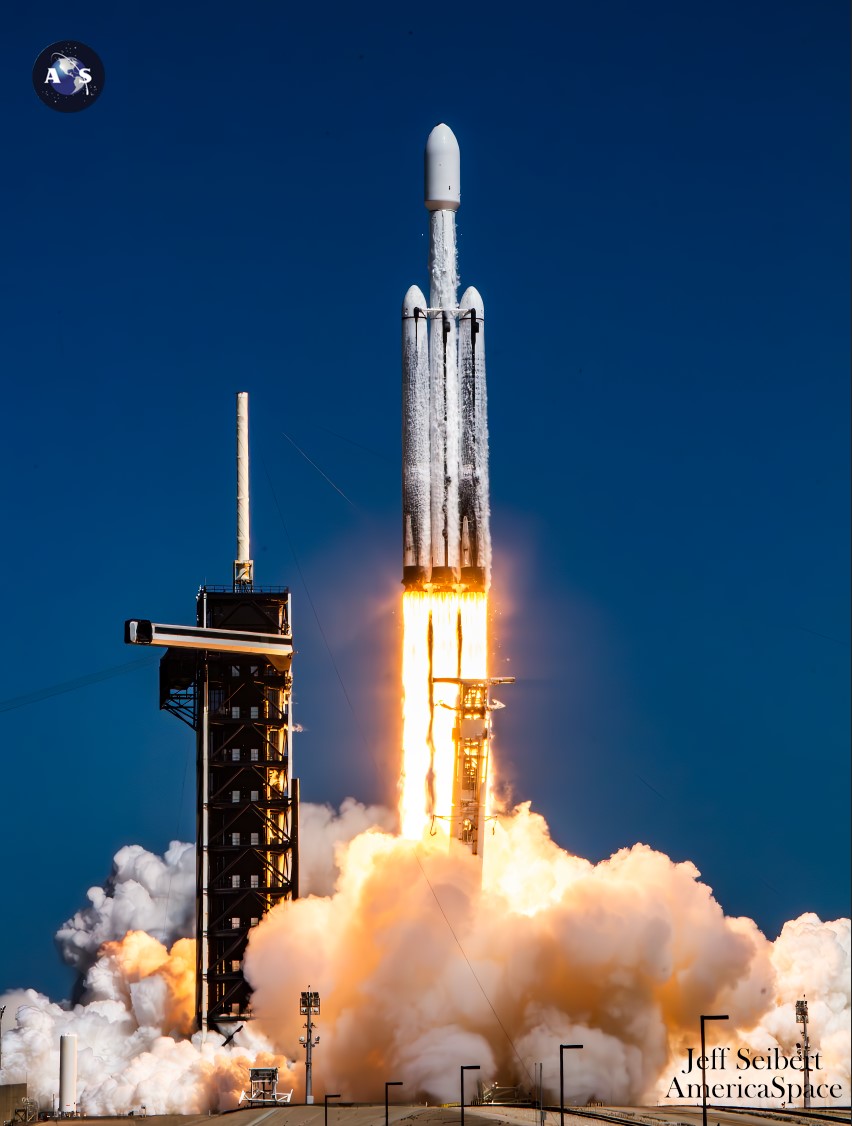
Like any flagship mission, Europa Clipper has faced its fair share of challenges. Inflation and supply chain issues caused its budget to balloon from 2.5 billion to 5 billion dollars. Most concerningly, a supplier delivered thousands of faulty transistors to NASA. The agency was unaware that they were not radiation-hardened until just five months before the launch. For a mission which was bound for the most hostile radiation environment known to mankind, this discovery was deeply concerning. It sparked widespread concern that Clipper would miss its launch date – potentially by multiple years [3]. Ultimately, a JPL team led by Jordan Evans found a way to fly the mission without replacing thousands of transistors. By using Clipper’s heaters to increase the temperature inside the spacecraft, JPL will be able to repair any radiation damage which takes place through a process called thermal annealing.
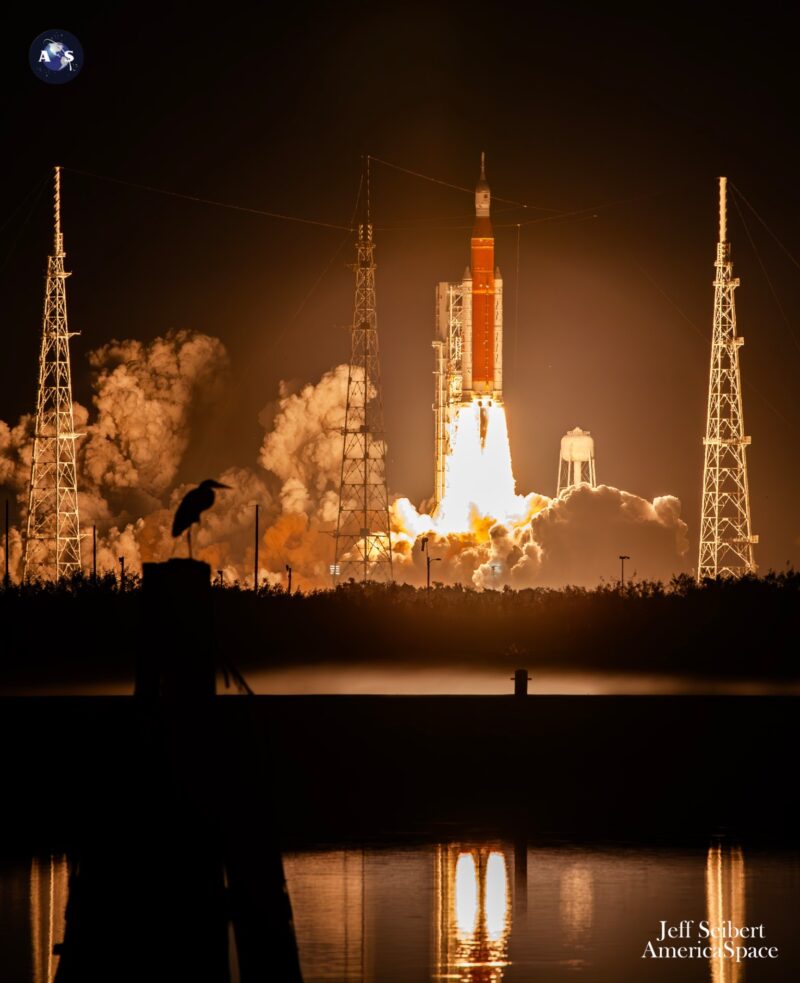
Selecting a launch vehicle also prompted years of confusion and uncertainty. Europa Clipper was originally slated to launch on NASA’s mighty Space Launch System rocket, which would have delivered it to Jupiter in just 2.5 years. While the scientific community was thrilled by the short transit, the engineers were concerned that the vibrations produced by the SLS’ powerful Solid Rocket Boosters would damage the spacecraft. To protect Clipper, NASA ultimately decided to launch it on a smaller – but still more powerful than anticipated – Falcon Heavy rocket.
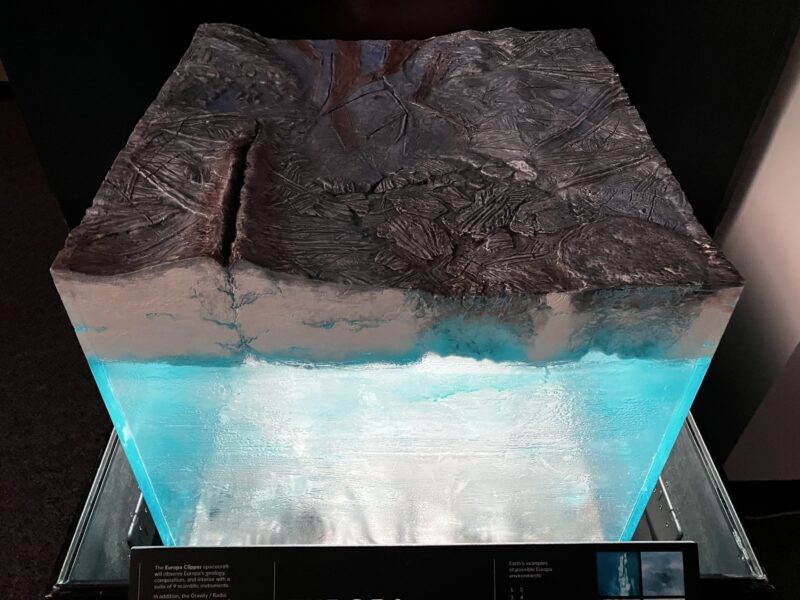
On Monday, October 14th, the Falcon Heavy put on a flawless performance. At 12:06 PM Eastern time, its twenty-seven Merlin engines roared to life. The rocket lifted off of historic Launch Complex 39A into a cloudless sky. Its side boosters were jettisoned 3 minutes and 12 seconds after launch. This was the final voyage for boosters B1064 and B1065, which were each making their sixth flight. Their previous payloads included NASA’s Psyche spacecraft, which is now en route to the postulated metallic core of a protoplanet. While Falcon Heavy side boosters typically fly back to Cape Canaveral for refurbishment and reuse, they had to be expended to place the massive Europa Clipper on its intended trajectory.
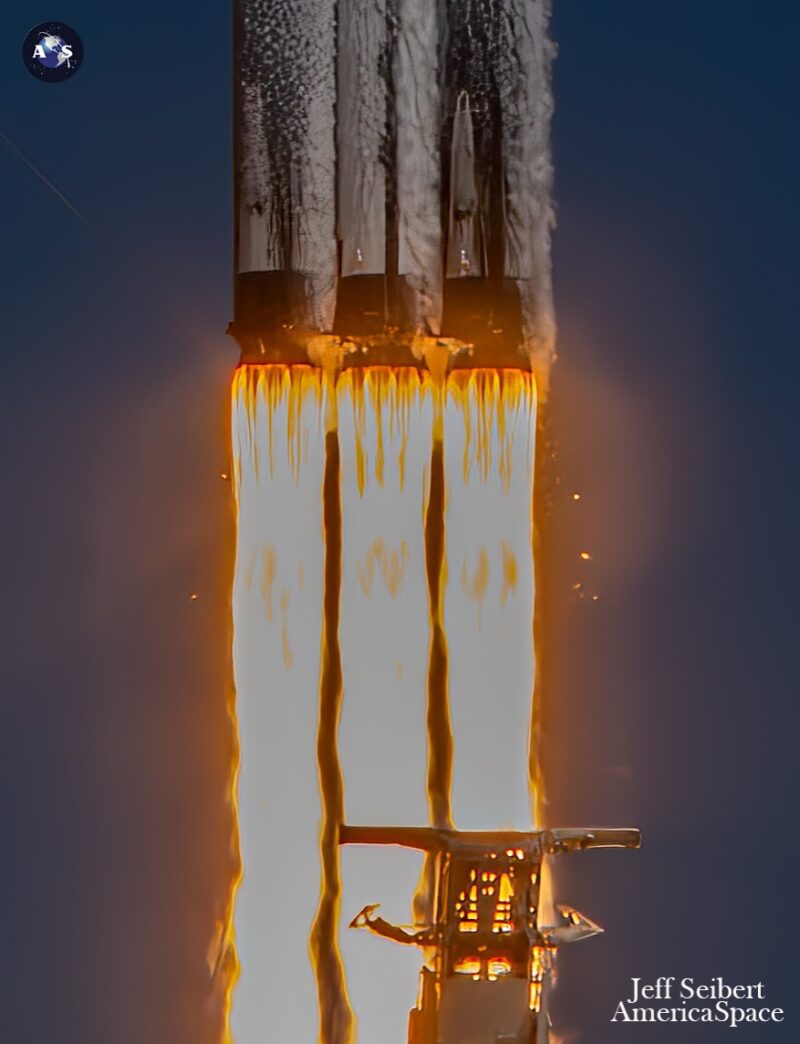
After the boosters were discarded, the core stage throttled up. It continued propelling the spacecraft towards orbit until it also likewise depleted its fuel and was jettisoned 4 minutes and 11 seconds into the flight. The second stage finished accelerating Clipper into a parking orbit with a 90-minute period. Its single Merlin Vacuum engine reignited 45 minutes later to complete the trans-Jovian injection maneuver. During the preceding Crew-9 mission, an identical Falcon 9 upper stage had failed to deorbit in its intended disposal area during the second burn of its engine. A Starlink mission in July failed due to an anomaly which occurred while relighting the Merlin Vaccum engine. Therefore, this final maneuver received some additional attention and concern, but the Falcon Heavy did its job perfectly.
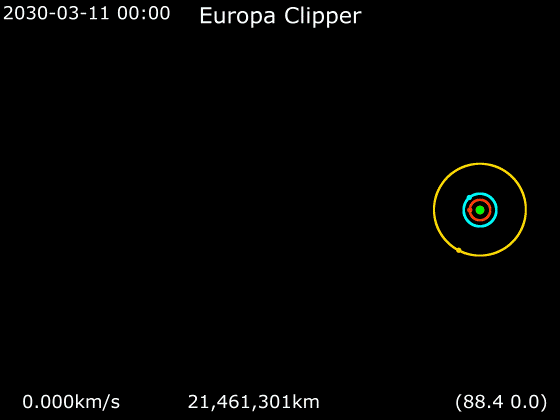
Following the separation of Europa Clipper, spurious telemetry indicated that both branches of the propulsion system was not venting properly. However, the spacecraft then autonomously initiated a planned “barbeque” thermal roll to prevent either side of the spacecraft from overheating in direct sunlight. This maneuver required a healthy propulsion system. Clipper also deployed its massive solar array wings, and two days after launch, it appears to be in good health.
While its ultimate destination is the Jupiter system, Europa Clipper is initially bound for Mars. Most spacecraft require 6-8 months to reach the Red Planet, but the power of the Falcon Heavy will enable Clipper to fly by its first destination in February of 2025. It will set a new record for the shortest cruise between the two worlds in the process. When a spacecraft flies behind a planet, it gains additional kinetic energy during a maneuver called a gravity assist. A subsequent gravity assist from Earth in December of 2026 will give Clipper a sufficient velocity to reach Jupiter on April 11th, 2030.
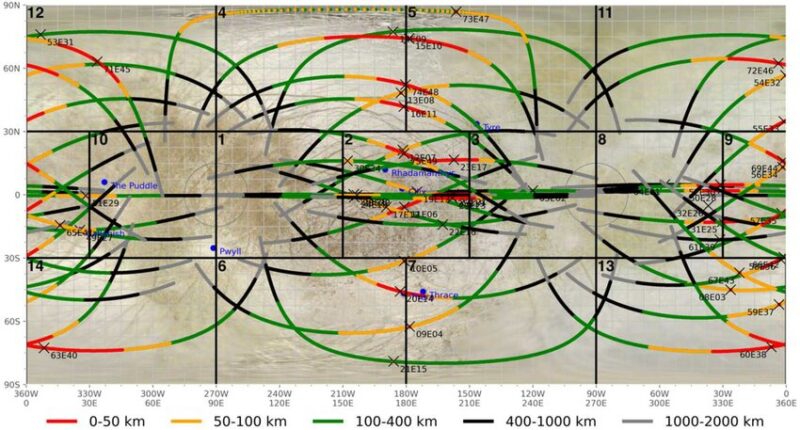
Europa Clipper will spend four years charting the mysterious surface and ocean of Europa. In total, 49 Europa flybys are planned. The ground tracks are widely distributed to allow Clipper’s cameras and spectrometers to study most of the moon’s surface in high-resolution detail. While Europa will be the probe’s primary focus, it will also conduct seven flybys of Ganymede and ten of Callisto. Like Europa, these heavily-cratered moons are suspected to be ocean worlds. Some members of the science team have also openly speculated about visiting the volcanic moon Io during a hypothetical extended mission.
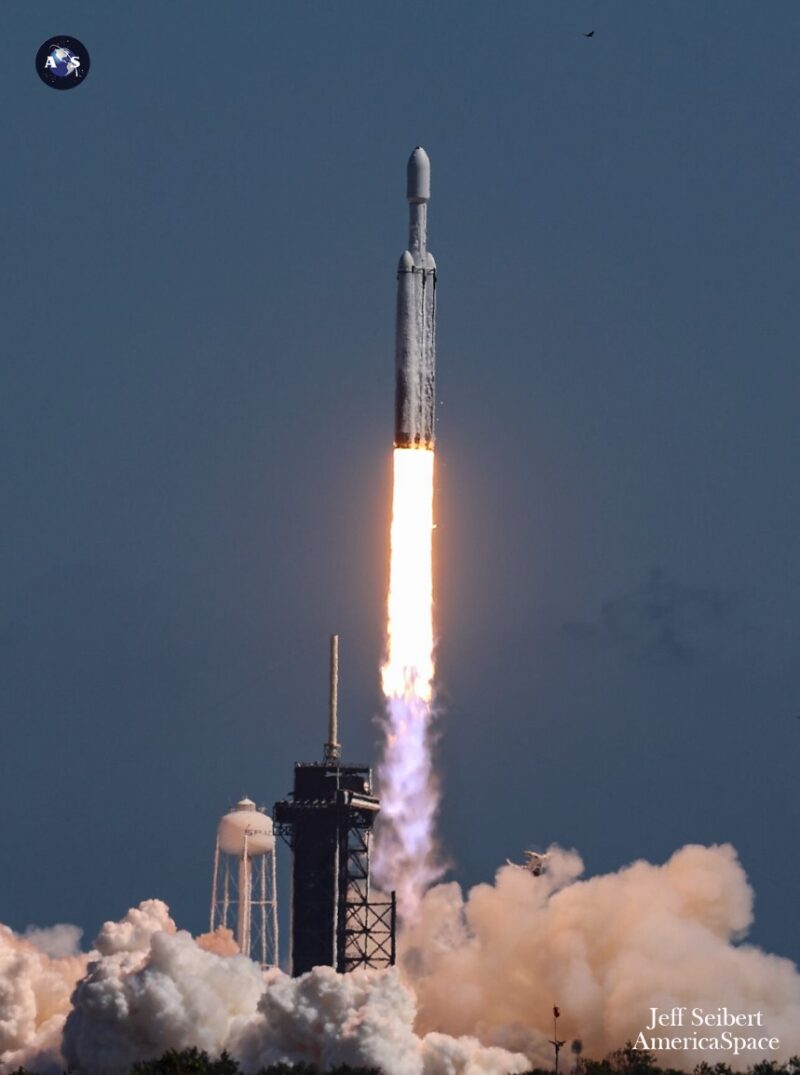
There are many reasons to explore space, both with astronauts and with robotic probes. Arguably the most profound is that exploration allows us to expand our imaginations and our perspectives as a civilization. Europa Clipper is one of the best examples of that fundamental, deep-seated quest for knowledge and beauty. It will undoubtedly reveal wonders: Jagged, icy spires sticking out of its surface; geysers potentially containing complex organic compounds; and Jupiter hanging imposingly above the surface of Europa. Planetary scientists and members of the pubic alike eagerly await its discoveries.

However, it is also important to recognize that this mission would never have happened without countless contributions from a diverse set of visionaries. Science fiction writers such as Arthur C. Clarke first brought Europa into the public consciousness. The Voyager and Galileo science team discovered its ocean, and then spent most of their lives designing and advocating for Europa Clipper so that younger scientists could benefit. Nearly 400,000 Americans from all walks of life petitioned Congress to fund the mission just because they thought it was worth doing. A bipartisan group of elected officials urged NASA to fund the mission, even when some of the agency’s leaders were initially reluctant to do so. Over 4,000 JPL engineers, plus countless others at the center’s subcontractors, worked for a decade to build the spacecraft. And finally, the NASA and SpaceX technicians at the Kennedy Space Center worked through Hurricane Milton to send Clipper on its journey before its launch window closed. If you, dear reader, are excited by the exploration of Europa, now is the perfect time to silently thank these people for all that they have done to make this historic voyage of exploration possible.
Follow AmericaSpace for space news, history, and more!
Missions » Europa Mission »